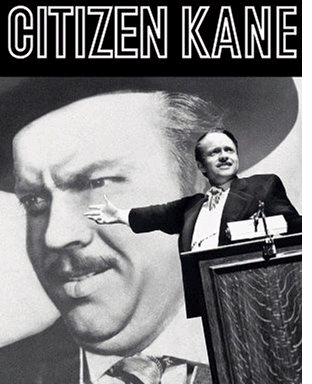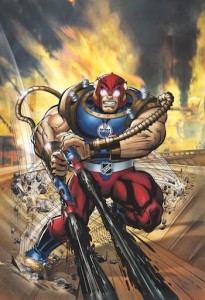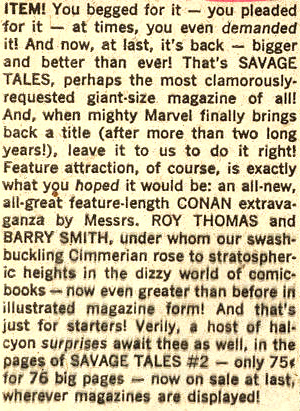The NHL’s Guardian Project is a misstep
The National Hockey League’s All-Star Weekend has come and gone, generally creating a positive buzz for professional hockey in North America.
The All-Star Fantasy Draft, where captains Eric Staal and Nicklas Lidstrom selected their superstar teams schoolyard style, was a huge success, averaging 600,000 viewers in the United States.
Unfortunately, the lingering product from the gala event in Raleigh N.C. is the Guardian Project, the NHL’s misguided attempt at drawing in today’s youth.
The Guardian Project is a marketing campaign where legendary comic book creator Stan Lee designs super heroes based off the names of all 30 NHL franchises.
Sounds good in theory, but in practice the idea plays out like a super villain’s hare-brained scheme. Stan Lee + comic books + hockey teams + ???? = world domination.
In other words, it’s not very well thought out.
The NHL Guardians are problematic from their very conception. First, Stan Lee simply doesn’t have as much cultural cache as he once did. After all, he hasn’t had a monthly title since Ravage 2009 in the early 1990s. You know, when the Guardian Project’s target demographic was still years away from being born.
Second, the characters themselves are lame. Witness Chris Sims of ComicsAlliance epic takedown: The Ten Most Insane Characters From Stan Lee's 'NHL Guardians'.
Many of the characters seem to be based on a brief skimming of each franchise’s Wikipedia page. Important details like the military heritage of the Chicago Blackhawks and Toronto Maple Leafs aren’t touched on at all.
Most importantly, the NHL’s marketing department is once again playing away from the game’s strengths.
Hockey is one of North America’s oldest sports, with the NHL’s Original Six predating any National Basketball Association franchise, only a handful of National Football League teams and most Major League Baseball clubs.
It’s a disgrace that the Montreal Canadiens, a franchise that is over 100 years old and a cornerstone of Quebecois society, is being represented by the likes of this:
But campaigns like Project Guardians relies on trendy thinking that makes the NHL seem newer than the Arena Football League or other shaky niche sports.
Seriously – the Tampa Bay Storm of the Arena Football League predate the Tampa Bay Lightning by five years. The Charlotte Rage were created and folded before the Carolina Hurricanes moved from Hartford, Conn. The list goes on and on.
Commissioner Gary Bettman and the rest of the powers that be at the NHL have to learn that if they really want to make inroads in the Sun Belt, they need to educate and inform their new fanbase about the rich history and tradition of the game, not disregard it.
Otherwise, the NHL comes off as just the latest in a long line of failed sporting enterprises.
That’s why innovations like the All-Star Fantasy Draft and the Winter Classic have been so successful: because they are reminiscent of the history and tradition of hockey.
It’s also why the NHL’s Guardians Project was a dreadful misfire: it glosses over one of the most appealing aspects of hockey.
Follow Friday – the Twitter Bullpen
Growing up I was fortunate to have access to my dad’s wonderful Silver Age collection of comics. Also, since I grew up in the 90s, I could pick up relatively cheap back issues from the medium’s second golden age, the 1980s.
As a result I’ve been exposed to some of the real magic of Marvel Comics. Obviously, the stories and artwork is the major draw of their library, but one of the really attractive things about these eras was the infamous Bullpen Bulletins.
In short, the Bulletins were a newsletter inserted into all of Marvel’s monthly titles that talked about the comings and goings of their roster of writers, artists and editors.
Really, it was an invention of editor-in-chief Stan Lee to promote new titles and new talent. The Bullpen Bulletins were always over-the-top and Barnum-esque but it was also entertaining and made you feel like you were right there with your favourite creators.
Marvel discontinued the feature in 2001, and I can’t say that I blame them. After all, the Bullpen itself had been dispersed by the advent of digital technology allowing a lot of freelancers to work from home.
Further, today’s creators are able to float between DC Comics, Marvel, Image, Dark Horse and other publishers, meaning that the esprit de corps that was at the heart of the Bulletins was seemingly at an end.
Twitter has rekindled that sense of camaraderie and taken it to the next level. Instead of getting to read monthly highlights of Bullpen sessions, comic book fans can now follow the jabs, jokes and work of all their favourite creators on a minute-by-minute basis.
The queen of the comics Twitter-verse has to be Gail Simone, the writer of Secret Six and Birds of Prey. She is one of the most active Tweeters out there. One of her regular “features” is to antagonize her fellow comic creators and hilarity often ensues.
Warren Ellis is the author of many books and magazine articles, but is also known for his comics work including Transmetropolitan, Nextwave, Planetary and Hellblazer. His Tweets are jovially cantankerous as he playfully abuses his followers.
A more light-hearted creator is Dan Slott, the current scribe of Spider-Man. He also penned a tragically short-lived run on the Mighty Avengers which recently concluded. He often discusses his writing process and things he loves about his job. It’s a fun read.
One of my favourite comic book writers is Kurt Busiek, the author of the brilliant creator-owned Astro City. He’s done a ton of other work for just about every comic publisher you can name. If you’ve never read it, his run on the Avengers with master illustrator George Perez is some of the best comics work ever.
Finally, there’s the duo of Ed Brubaker and Matt Fraction, who have turned the Marvel universe on its ear in the past few years.
Brubaker just finished an incredibly strong run on Daredevil and continues to pen Captain America. Fraction is the current mind behind the X-Men, Thor and the Invincible Iron Man. The two collaborated on the Immortal Iron Fist, a joy to read that ended too soon.
There are myriad other creators on Twitter, but these are a few of my preferred feeds. It’s fun and exciting to see the Bullpen continue on, at least in spirit, in the digital age. If you’re a fan of comics, you should try looking up your favourite writer and artist and get to know them just as Stan Lee once envisioned.
The Return of the Superhero Originality Game
 A recent strip from Let’s Be Friends Again by Chris Haley and Curt Franklin perfectly sums up how I feel about Marvel and DC Comics. Basically, I think that the two major purveyors of sequential art are in a creative malaise largely of their own making.
A recent strip from Let’s Be Friends Again by Chris Haley and Curt Franklin perfectly sums up how I feel about Marvel and DC Comics. Basically, I think that the two major purveyors of sequential art are in a creative malaise largely of their own making.
A few weeks ago, I wrote about an exercise - the Superhero Originality Game – that highlights that stagnation. The rules are explained at length in my previous post but, in short, the idea is to try and think of completely original characters that were created in the past thirty years that could (or have) carried their own monthly titles for Marvel or DC Comics.
I had gotten the ball rolling with a list of 10 characters who met the criteria:
1.Booster Gold
2.The Sentry
3.Wild Dog
4.Speedball
5.Elektra
6.Venom (Eddie Brock or Angelo Fortunato but not Mac Gargan)
7.Amanda Waller
8.Terror Inc.
9.Deathstroke
10.Deadpool
I had invited my readers to try and add to the list, and they came up with an additional 14 characters:
11. Rage
12. Night Thrasher (Dwayne Taylor, not his brother Donyell Taylor, aka Bandit)
13. Amadeus Cho
14. War Machine
15. Zauriel
16. Shatterstar
17. Magog
18. Beta Ray Bill
19. Lobo
20. Cloak and Dagger *
21. Cyborg
22. Raven
23. Starfire
24. Silver Sable
The point of the game was to try and highlight the fact that, to a large extent, the Big Two comic book publishers have produced less than one new marketable character per year. It’s not just that they’re no longer creating new series, there aren’t many original characters being created, period.
Instead, comic book fans are being treated to Spider-Man fighting the Vulture. Again. Or another Teen Titan dying. Rehashing and re-telling seems to be the name of the game.
It’s a disappointing trend.
Imagine if two major television networks like ABC and NBC only introduced a total of 24 new television shows over the course of three decades? Advertising revenue would quickly dry up and they’d be out of business. The stagnation would have killed them.
One thing I’ll say about these 24 characters is that they are an impressively diverse group. Six and a half (Cloak being one half of an entry)are visible minorities. Five and a half are women. One is a space horse.
They also have diverse origins and motivations, with at least 12 of them being spanning from “morally ambiguous” to “ethically reprehensible”. Whether they are mercenaries, assassins, exceptionally greedy or intelligence operatives for the government, they’re a surprisingly complex group of protagonists.
Unfortunately, only five are currently starring in a book, either in a solo title (Booster Gold, War Machine, Amadeus Cho, Deadpool) or a team book (the Sentry). Even in that group, War Machine’s book is being cancelled and there are rumours that the Sentry is going to be killed as part of the Siege.
This lack of creativity is particularly stunning when you think of all the characters that Stan Lee and Jack Kirby created for both companies between 1960 and 1975. Together and separately they produced dozens of enduring characters. Why can’t their success be replicated even a little?
I think the big problem is that Marvel and DC Comics are incredibly risk averse and reluctant to try anything new. Instead, they’d rather play it safe and go back to the well time and time again, appeasing a hardcore group of fans rather than reach out and try out new characters that could appeal to a broader base of readers.
It’s a crying shame that in the long run will hurt the comics business.
*I looked into Cloak and Dagger and it’s kind of up in the air as to whether or not they’re mutants. They’ve been described as having powers that were activated by the experiments they were subjected to. To keep it simple, we’ll just assume that they’re not mutants.
Citizen Kane Syndrome
 According to the American Film Institute, Citizen Kane is the greatest movie ever made, but when was the last time you saw it on TV? Only high-brow movie channels like Turner Classic Movies or maybe Bravo! will show it, and likely not very often. You’ll never see it as a Fox Saturday matinee or as part of Peachtree’s weekend movie marathon.
According to the American Film Institute, Citizen Kane is the greatest movie ever made, but when was the last time you saw it on TV? Only high-brow movie channels like Turner Classic Movies or maybe Bravo! will show it, and likely not very often. You’ll never see it as a Fox Saturday matinee or as part of Peachtree’s weekend movie marathon.
Why is that? It’s indisputably great, having influenced just about every film made after it and changing the way people saw cinema. But plunk your average movie-goer down in front of Orson Welles’ opus, they’ll likely fall asleep or try switching the channel.
This is what I like to call Citizen Kane Syndrome.
CKS afflicts many movies, but Citizen Kane has all the symptoms: an older, influential work that has become a fixture in culture. It lost its lustre because of its cultural significance.
Contemporary viewers don’t enjoy it because they’re already familiar with many of the artistic touches that made the film brilliant.
Most people don’t realize it but Citizen Kane was the first film to show the ceiling in a room. It’s true. Cameras had never been canted to such a degree that the roof was visible – until 1941 when Citizen Kane came out. It was the first movie to use deep focus throughout. It was pioneered special effects make-up. And on and on.
At the time, these were exciting new narrative techniques. Today? Mehn.
There are countless other aspects of the film that, at the time, were revolutionary, but today are taken for granted.
And, really, how thrilling can a plot twist be when Rosebud’s identity is revealed in a spoof on Tiny Toons?
It happens in every corner of pop culture too.
Stan Lee and Jack Kirby’s incredible run on Fantastic Four launched the Marvel Age. But some of its magic has been lost as the medium and craft have built upon that foundation.
The Beatles were once bigger than Jesus, but now fans of rock music expect faster beats, more complex chords and higher production values.
In Cold Blood remains a chilling look at two murderers, but its impact as creative non-fiction is not what it once was, since the New Journalists (and the New New Journalists, for that matter) have followed Truman Capote’s lead.
CKS forces media consumers into the tricky position of having to consider the historical context of the art not just politically or economically, but creatively as well. This can be a taxing requirement, and it only takes away from the viewing experience.
At the same time, there are some films, books and bands which remain timeless. Shakespeare is the easy example, but the Wizard of Oz (the movie, not the novel) also comes to mind.


